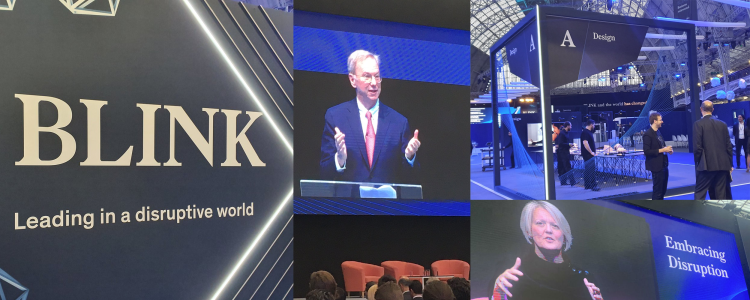As Director of a small design and innovation agency, I was lucky enough to be invited to attend McKinsey’s 2019 Blink conference. Over 1000 senior business leaders, brought together to debate the opportunities and challenges created by digital disruption. I was excited to find that speakers included former Google CEO, Eric Schmidt and new Royal Bank of Scotland CEO, Alison Rose.
Whilst the conference itself touched on many hotly debated topics, the main theme centred around how - due to the rate of technological advancements and market disruptors - change is only going to get faster.
Throughout the day, I noted several key takeaways from the panel discussions I attended, 4 of which I’ve detailed and resonate with the work we, at The UX Agency, are doing for our own clients.
1. Design can lead to double revenue growth
2. Companies MUST move at pace
3. Invest in people and company culture
4. Transformation needs to stick to be successful
1) Design can lead to double revenue growth
When design means the process of understanding customer needs, and creating products and services to meet those needs - revenue growth can be doubled.
This applies to physical, digital and service design. Design is not just about aesthetics. The bigger the gap between your customers and those who create the products, the bigger the opportunity for your more agile user-centered competitors to gain traction. Complacency also leads to failure.
“Put User-Centric design at the center. If you don't move from product centric to user centric you will never be agile enough to survive in today's world”
2) Companies MUST move at pace
The pace of change is never going to be this slow, new ways of working & new skills are needed to keep ahead.
Use partnership models to get there faster
Focus on doing one thing really well and iterate at speed
The biggest learnings come from mistakes - I knew what to do - And I didn’t do it quick enough
3) Invest in people and company culture
Invest in your people, ensure a good cultural fit, and ensure the culture is a good fit for your people. Build and nurture skills and give everyone on your staff a customer centric purpose.
At the end of the day it's all about the people, it's vital to attract the right people, coach them and help them to thrive in change. You don’t coach an individual - you coach the team.
4) Transformation needs to stick to be successful
70% of efforts to fundamentally transform an organisation don’t work. Innovation “hubs”, “garages” and “labs” don't work. However, leading change through multiple small projects, incrementally building on the methods and learnings from the last will. Involve people from across the business, bring in external help if necessary, but be sure to continually communicate and scale the success.
Digital transformation is hardly about technology, it’s about people. And companies over index on hiring a new whizzy technical person vs re-wiring the entire culture of the organisation.
Conclusions
The impact of technology on how fast people are able to work has consequences for the speed of disruption for organisations. Disruption has always existed, but the pace at which this occurs is what has changed and will continue to accelerate exponentially. To coin a McKinsey phrase, “The pace of change is never going to be this slow again.”
McKinsey’s Blink conference demonstrated to me that now more than ever organisations are seeing that to thrive they need to align around a customer centric purpose and a culture & processes that allows them to rapidly understand evolving customer needs to innovate and iterate products and services to lead in a disruptive world.

